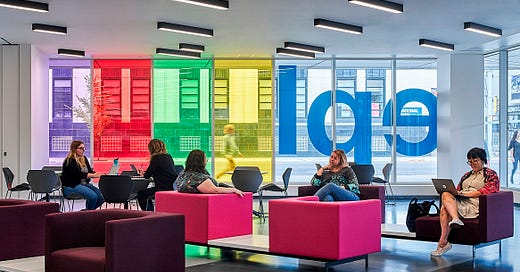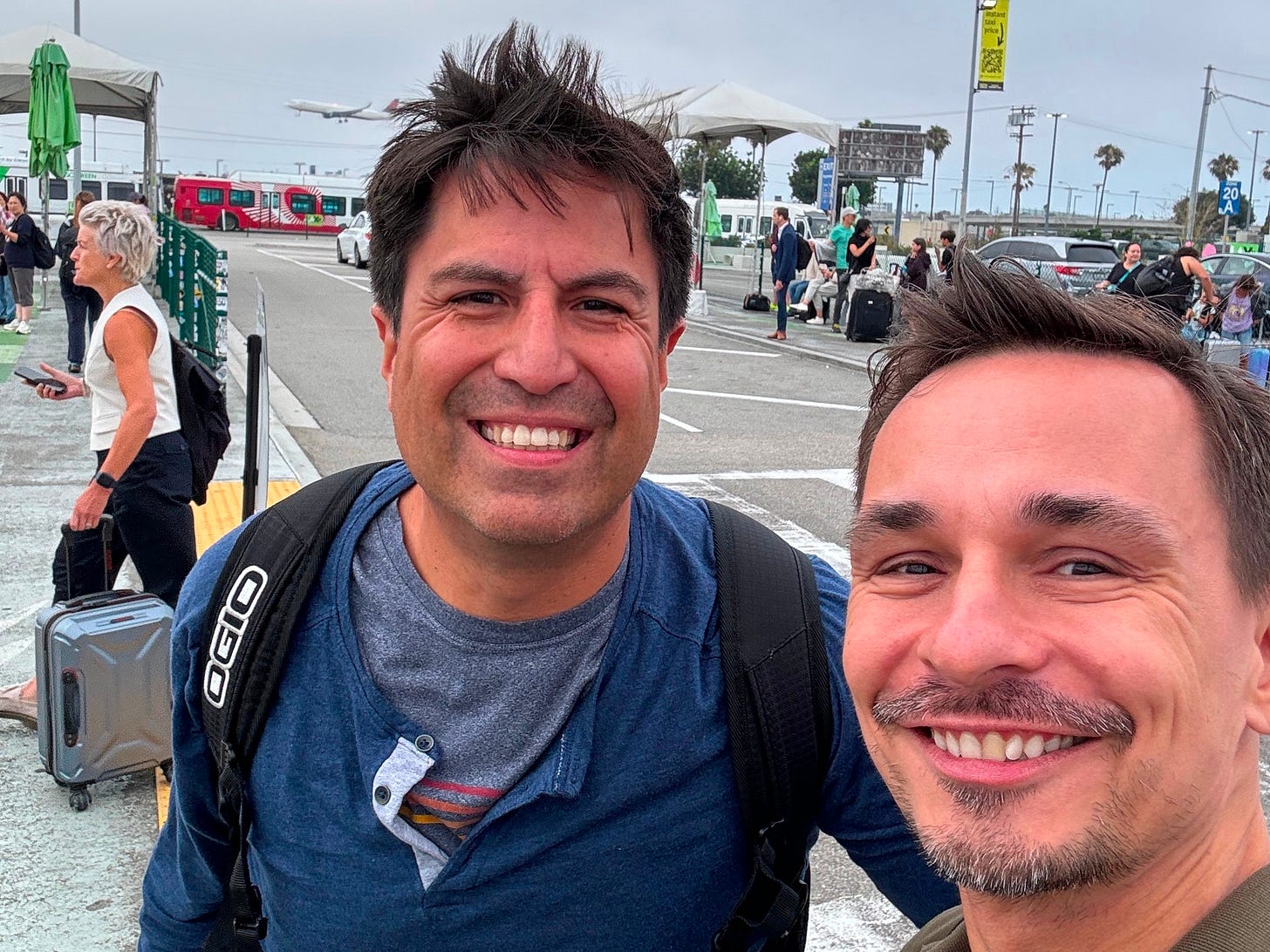Case Study: Promoting Convivencia at the Library
Edmonton Public Library is the first North American library to adopt convivencia as a strategic principle. CEO Pilar Martinez explains why a Latin American concept resonates in Northern Canada.
In 2023, I got an opportunity to visit the libraries of Calgary, Edmonton and Toronto and engage with staff on convivencia. My secret dream was to start a design project with one of the libraries to explore how convivencia helps set expectations, understand experiences and provide support at the public library.
That dream came true in Edmonton.
In September 2023 I was honored to be invited to be the Leader-in-Residence at Edmonton Public Library. Over two days, I engaged with municipal and library leaders and staff. A couple months later, Pilar Martinez, the CEO, and Corrina Chetley-Irwin, the Executive Director for Employee Experience, reached out with an open question: could we explore convivencia together here in Edmonton?
As we went deeper in our planning, I asked Ruben Ocampo, the Founder of Conic Group, to join me as collaborator. I got to know Ruben as an innovation coach when the City of Helsinki took part in the Bloomberg-Harvard City Leadership Initiative. Ruben’s approach was focused and empathetic. He demonstrated curiosity and appreciation to the work of public sector staff. Over the last decade he has coached numerous cities in public innovation.
My years in Helsinki convinced me that human-centered design is a powerful approach to explore convivencia. Pilar and Corrina identified an opportunity to learn about two things within the same project: public innovation and convivencia.
We decided to focus on customer experience, physical spaces and employee experience. We structured the project in five stages, inspired by practices of design thinking and public innovation. Each phase started with open exploration (divergent thinking) and resulted in making decisions (convergent thinking).
Ruben and I worked as a team throughout the project. My role was to oversee the strategic direction and ensure the focus on convivencia. I also led the first exploration phase and the last phase of making the lessons stick. Ruben led the parts of assessing the organization’s current state of convivencia through observations and interviews, coaching the teams on ideation and supporting them in experimentation.
We understood very quickly that we were working with an award-winning public library and framed our approach as going from great to greater. CEO Pilar Martinez said in our kick-off that they have “good bones” for convivencia. EPL staff members demonstrated focus and commitment to excellence. The stereotype about Canadians being nice proved to be true.
We were doing something for the first time and we revised the approach several times along the way. After ideation we understood that convivencia could be approached as a mindset across the organization rather than a separate project. We revised our approach from experimentation to policy making and planning.
One of our major successes was joint storytelling at the very beginning of the project. I collaborated with with staff member volunteers from all organizational levels and from multiple branches and functions to develop a localized narrative of convivencia. This was crucial for two reasons:
to motivate local ambassadors for the convivencia work
to make sure the language we used aligned with EPL’s reality
The staff members were amazing. They took pictures, interviewed colleagues and customers and did reference work. Their contributions made sure that our approach aligned with EPL’s community-led service philosophy and their commitment to truth and reconciliation.
The result, EPL’s Convivencia Framework, is a concise description of why convivencia matters, what are the specifics of convivencia in Edmonton, what are the support and expectations to the public and staff and what is the impact of convivencia to the library and Edmonton as a whole.
During our six-month collaboration, we engaged with EPL staff in online and in-person workshops, online collaboration platforms, during site visits and with surveys. We generated, analyzed and clustered nearly 1,000 suggestions and ideas on how to make convivencia a reality.
As a result, Edmonton Public Library is now the first public library system that has incorporated my approach to convivencia into their leadership and organizational practices.
As we concluded our collaboration in December, I talked to Pilar about the process.
Pilar Martinez, CEO of Edmonton Public Library:”This collaboration gave us a word for what we are facilitating in our spaces.”
Tommi Laitio: Let’s start from the beginning. Why do you think convivencia was a theme worth exploring for Edmonton Public Library?
Pilar Martinez: I think it gave us a word for what we are facilitating in our spaces and named some capacities that are required. When I first heard you talk in Washington, DC, I felt like you had filled in the blank of what happens in libraries every day and how we need to reframe our viewpoint around things that are a little bit uncomfortable in a healthy way. You had the word and the language to describe it, and a roadmap around what capacities to facilitate. When I came back [to Edmonton] and talked about it, people were really excited. I heard you again in Toronto and got even more excited. And then you did the Leader-in-Residence [at Edmonton Public Library], which got us even more excited. So we thought that this is the right thing to implement or to explore.
Tommi: During our branch visits and workshops it was clear that convivencia really resonates with staff. Why do you think that is?
Pilar: I think that staff have language to describe what happens in our spaces. It's a mental model we can apply to prepare for conversations. It's similar to what we've been doing in building a culture of open feedback. It's uncomfortable to get feedback while feedback is really about generosity, growth and learning.
We talked about being Canadian when you and Ruben were here. We have more of an emphasis on being polite. So those little things that other cultures might not consider uncomfortable are often uncomfortable to us. I think just acknowledging that as individuals, we can choose to perceive things differently. We're talking about the day-to-day where somebody might want something different than somebody else in the same space.
Tommi: You remind me of something I learned in Helsinki at a leadership training that is not easy to remember: that people who are critical believe in the future of the institution.
Pilar: Have I told you about the three questions we use? It's based on this thing called leaders’ discipline. The idea is to make feedback more palatable. You start with what worked well. And then a more neutral question around what was tricky. And then you do the most kind of heavily judgmental question: what could you have done differently? And you start with the individual who is receiving the feedback, giving themselves feedback. And nine times out of ten, the person giving the feedback is way harder on themselves and nails it. Then the second person who's giving the feedback says:”Would you like to hear some feedback from me?” So you're asking for permission. Most of the times you're just validating what the individual has said.
Tommi: So you talk about convivencia to tons of people, your governing boards, your partners and so on. What's the description that you use?
Pilar: I use your metaphors of dance or being together during a holiday dinner with family.
I also use an example from a visit to Calgary Public Library. [During a branch visit], the librarian was saying that there were two teenagers in the very small children's area. They were engaged, they had a laptop, and they were quiet. So the librarian told us that they don't make a big deal if the demographic that's in the space isn't who the space was intended for. What they do, though, is say that you're more than welcome to stay here but if there are some little ones who come, the only thing I'm asking is that you play Lego with them or you read a story. And she said that they do.
I actually got an email about this example from a staff member this week. The staff member said that he had some teens in the kids area. He tried that and they were actually engaged. That's beautiful.
For me still, the dance gets to it. You're at a dance, you're there with a partner, and then you're not dancing with your partner, you're dancing with music. You don't really love it. Next thing you know, you're dancing with a group of people. Somebody steps on your toe. That's how I've been describing it. That's how we grow. It is discomfort but not bad discomfort.
Tommi: So we just concluded this six-month convivencia project with Edmonton Public Library. What are the actions EPL has taken, or is taking, to celebrate and promote convivencia?
Pilar: A number of actions:
We have our framework. It's a roadmap showing what our goal is and what we are hoping to achieve.
All managers have a goal focused on convivencia related to our leadership promise.
The teams are all encapsulating the concept of convivencia in their 2025 goals.
The customer experience framework now includes the concept of convivencia based on your Leader-in-Residence.
Our foundational training will include how convivencia fit in these different pieces, including managing conflict.
The branch services are developing a conversation guide that managers can use in staff meetings to have conversation.
It’s in our Inclusion and Belonging Framework.
So it really is permeating everything we do. We have a leadership retreat in January to go deeper. And this is just the beginning.

Tommi: That's really amazing to hear. What has been really impressive in working with EPL is how strategic you are. For instance, you are quite intentional in the language you use and don’t use. I don't see that level of detail very often.
Pilar: Thank you. You and Ruben have been a pleasure to work with. Your adaptability and our adaptability has been instrumental for our success. Being so very open to that.
Key Lessons on Convivencia from Our Work with Edmonton
Write a localized narrative of convivencia together with staff.
Use images and drawings to make convivencia concrete.
Highlight and recognize existing practices that model convivencia.
Integrate convivencia into existing strategies, projects and practices at the organization, branch, and team levels.
Remind staff about the training and supports available for navigating discomfort and develop additional tools and training as needed.
Continue to learn from people and places outside your library.
Be open to revising your project plan.
The work builds on research carried out at Bloomberg Center for Public Innovation at Johns Hopkins University / Tommi Laitio.
















This is such a huge accomplishment and I’m not surprised that Edmonton was first out of the gate! This would be great to see and be part of here in Calgary!
What a valuable post. Thanks for sharing. Can the EPL's convivencia framework also be shared? And do you believe the Leader-in-Residence -- you! -- is critical to making this work in a similar public system?